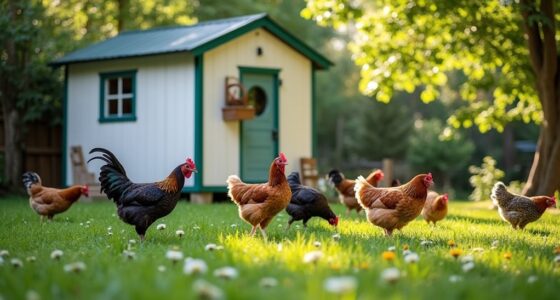To build a safe chicken coop, focus on proper ventilation with adjustable vents placed high on walls to promote airflow and reduce moisture. Use predator-proof materials, such as hardware cloth with small holes and pressure-treated foundations, to prevent tunneling and break-ins. Make certain all openings are sealed with secure latches, and the roof is sturdy and predator-proof. Also, include easy access for cleaning and maintenance. Keep exploring to learn how to perfect each aspect for a healthy, secure home for your chickens.
Key Takeaways
- Incorporate proper ventilation with adjustable vents placed high on walls to ensure airflow and prevent drafts.
- Use predator-proof materials like hardware cloth and bury fencing at least 12 inches underground.
- Build a sturdy, secure structure with a lockable door and covered openings to prevent predator access.
- Ensure the roof is made of heavy-duty or metal materials to stop climbing or flying predators from entering.
- Design easy access for cleaning and maintenance, including a wide door and secure nesting area separate from the coop.

Are you ready to build your own coop? Crafting a safe, durable home for your chickens starts with understanding some key basics. The foundation of a good coop hinges on proper ventilation design and predator proofing tips. These elements guarantee your flock stays healthy and secure, no matter what threats or weather conditions come your way. Ventilation is essential because it helps maintain fresh air inside, reducing humidity and preventing respiratory issues. When designing your coop, include windows or vents that can be opened and closed, allowing you to control airflow based on the weather. Avoid placing vents directly in the path of prevailing winds to prevent drafts, which can chill your birds. Instead, position them higher up on the walls to promote airflow while keeping the interior warm and comfortable. Proper ventilation also helps minimize moisture buildup, which can lead to mold or frostbite in colder months.
Predator proofing tips are equally critical. Your chickens are vulnerable to raccoons, foxes, rats, and even neighborhood cats. To keep these predators out, start with a sturdy base—use pressure-treated wood or cinder blocks for the foundation and bury the fencing at least 12 inches underground to prevent digging predators from tunneling in. Strong, hardware cloth fencing with small holes (no larger than half an inch) is best, as chicken wire can be easily chewed through. Install secure latches on all doors and windows; avoid simple hooks that predators can manipulate. For added security, consider using padlocks or carabiners. Cover any openings with hardware cloth, and make sure there are no gaps or weak spots. The roof should be predator-proof as well—metal or heavy-duty roofing materials are ideal to prevent climbing predators from gaining access from above.
When designing your coop, think about accessibility for cleaning and egg collection. Include a sturdy door that swings open wide for easy access and a separate nesting box area that predators can’t reach into. Keep food and water in secure containers inside the coop to avoid attracting pests and predators. Regular maintenance is key—inspect your fencing and structure often for signs of wear or damage, especially after storms or heavy winds. With a well-thought-out ventilation design and predator proofing tips in mind, you’re well on your way to building a safe, comfortable, and productive home for your chickens. Remember, a little planning now saves you headaches later, guaranteeing your flock remains healthy and secure for years to come.
Frequently Asked Questions
How Do I Prevent Predators From Accessing the Coop?
To prevent predators from accessing your coop, you should install predator-proof fencing that’s buried underground to stop digging animals. Use secure latches on all doors and windows, ensuring they can’t be easily pried open. Regularly check for weak spots or holes and repair them promptly. Keeping the area clean and secure reduces hiding spots for predators, giving your chickens a safer environment and peace of mind.
What Materials Are Best for Insulation?
When choosing insulation types and insulating materials, you want options that shield your chickens from extreme temperatures, moisture, and pests. Foam board insulation offers excellent R-value and durability, while spray foam provides seamless insulation and moisture resistance. Mineral wool is fire-resistant and soundproof, and reflective foil insulation helps keep heat out. Select materials that are safe, non-toxic, and easy to install to guarantee a cozy, protected environment for your chickens.
How Much Ventilation Is Sufficient?
You need enough ventilation to guarantee proper airflow regulation without creating drafts. Aim for a ventilation design that provides 1 square foot of vent space per 10 square feet of coop floor area. This balance helps keep the coop fresh and prevents moisture buildup. Regularly check and adjust vents as needed, especially during extreme weather, to maintain a healthy environment for your chickens. Proper ventilation keeps them comfortable and reduces health risks.
How Do I Ensure Easy Cleaning and Maintenance?
Ever wonder how to keep your chicken coop spotless without hassle? You need a clear cleaning schedule and a maintenance checklist to stay ahead. Design your coop with removable trays, accessible doors, and smooth surfaces—these make cleaning easier and faster. Regularly inspect for wear and tear, and address issues promptly. This way, you guarantee a healthy, stress-free environment for your chickens and less work for you.
What’s the Ideal Size for Different Flock Sizes?
You should choose a coop size based on your flock size, ensuring each chicken has about 3-4 square feet of space inside. For larger flocks, opt for bigger coops with good ventilation to prevent overheating and moisture buildup. Install predator-proof locks on doors and windows to keep your chickens safe. Proper size and secure locks create a comfortable, healthy environment, making maintenance easier and reducing stress for your birds.
Conclusion
Now that you’ve built your coop, imagine the soft cluck of your chickens settling in at dusk, their feathers rustling in the breeze. With sturdy walls and a secure roof, you’ve created a safe haven where they can thrive. Every nail and plank becomes part of their peaceful sanctuary, a cozy refuge under the open sky. Watching them roost happily, you’ll know your effort has built more than a coop—it’s a home for your flock to flourish.










